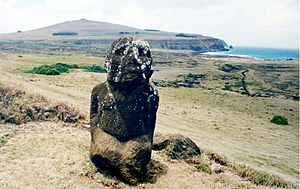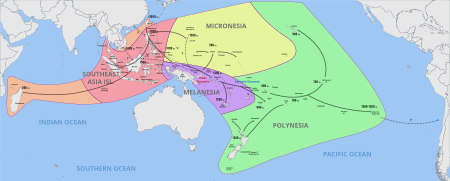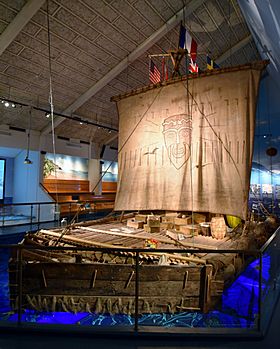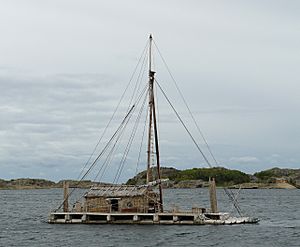Kon-Tiki expedition facts for kids
The Kon-Tiki expedition was an amazing journey in 1947. A group of explorers sailed a raft across the Pacific Ocean. They traveled from South America all the way to the islands of Polynesia.
The leader of this adventure was a Norwegian explorer named Thor Heyerdahl. He named the raft Kon-Tiki. This name came from an old name for the Inca god Viracocha.
Heyerdahl had a big idea. He thought that people from South America might have sailed to Polynesia long ago. He wanted to prove it was possible using old building methods. The expedition used only materials and tools that ancient people would have had. They did carry some modern gear like a radio and watches. But Heyerdahl said these were just for safety, not for proving his main point.
Scientists today mostly disagree with Heyerdahl's full idea. Most evidence shows Polynesians came from Island Southeast Asia. They used advanced sailing skills and boats. However, new studies show some ancient contact between South America and islands like Easter Island.
The Kon-Tiki expedition got money from private loans. They also received equipment from the United States Army. Heyerdahl and his team went to Peru. There, they built the raft using balsa logs and other local materials. They built it just like ancient drawings showed.
The journey started on April 28, 1947. Heyerdahl and five friends sailed the raft for 101 days. They covered about 6,900 kilometers (4,300 miles). On August 7, 1947, the raft hit a reef near Raroia in the Tuamotus islands. Everyone on board made it safely to land.
Thor Heyerdahl wrote a book about his adventure. It became a huge bestseller around the world. A film about the expedition, also called Kon-Tiki, won an Oscar in 1951. The original Kon-Tiki raft is now on display. You can see it at the Kon-Tiki Museum in Oslo, Norway.
Contents
The Brave Crew
The Kon-Tiki had six brave men on board. Most were Norwegian, but one was Swedish.
- Thor Heyerdahl (1914–2002) was the leader of the expedition. He wrote the book and narrated the film. Heyerdahl had studied ancient people. He believed there was a link between South America and Polynesia.
- Erik Hesselberg (1914–1972) was the navigator and artist. He painted the big Kon-Tiki figure on the raft's sail. He also wrote a children's book called Kon-Tiki and I.
- Bengt Danielsson (1921–1997) was from Sweden. He managed the supplies and food for the crew. He was also the only one who spoke Spanish, so he was the translator.
- Knut Haugland (1917–2009) was a radio expert. He was a hero in World War II. He helped stop Germany's plans to build an atomic bomb. He was the last crew member to pass away.
- Torstein Raaby (1918–1964) also handled radio transmissions. He had spied on a German battleship during WWII. His secret radio messages helped sink the ship.
- Herman Watzinger (1910–1986) was an engineer. He joined Heyerdahl first. He collected important data during the trip. This included weather information for scientists.
The expedition also had a pet parrot named Lorita!
Building the Raft
The Kon-Tiki raft was built using traditional methods. No metal was used in its construction.
- The main part of the raft had nine balsa tree trunks. They were up to 14 meters (45 feet) long. These logs were tied together with strong hemp ropes.
- Shorter balsa logs were tied across the main logs. These gave the raft extra support.
- Pine boards were added to the front to help with splashes. Other pine boards were placed between the balsa logs. These acted like centreboards, helping the raft steer.
The main mast was made of mangrove wood. It was about 9 meters (29 feet) tall. Behind the mast was a small cabin. It was made of woven bamboo and had a banana leaf roof. At the back, there was a long steering oar. The main sail was made of bamboo stems.
Food and Water
The Kon-Tiki carried a lot of supplies.
- They had 275 gallons (1,040 liters) of drinking water. It was stored in cans and sealed bamboo rods. Heyerdahl wanted to see how well ancient water storage methods worked.
- For food, they brought 200 coconuts. They also had sweet potatoes, gourds, and other fruits and roots.
- The U.S. Army Quartermaster Corps gave them tinned food and survival gear. In return, the crew reported on how good the supplies were.
- They also caught many fish during the trip. This included flying fish, dolphin fish, yellowfin tuna, and shark.
The crew wore special waterproof watches. After the journey, the company that made them named their sports watches "Kon-Tiki."
Radio Communications
The expedition had an amateur radio station. Its call sign was LI2B. Knut Haugland and Torstein Raaby operated it. They were both experienced radio operators from World War II.
They talked regularly with radio stations in America, Canada, and South America. These stations shared the Kon-Tiki's location with the Norwegian Embassy. On August 5, Haugland even talked to a station in Oslo, Norway, which was 10,000 miles (16,000 km) away!
The raft's radios used batteries and a hand-cranked generator. They were waterproof. The main radio receiver got soaked once. The crew had to dry it out carefully. They even sent an "all well" message once. This stopped a big rescue attempt that was about to happen.
The Amazing Voyage
The Kon-Tiki left Callao, Peru, on April 28, 1947. A Peruvian Navy tugboat towed them about 50 miles (80 km) out to sea. Then, the raft sailed west. It was carried by the Humboldt Current.
On July 2, Heyerdahl wrote about a "rogue wave." He described three huge waves that swept over the raft. But after them, the sea became calm again.
The crew first saw land on July 30. It was the atoll of Puka-Puka. On August 4, the 97th day, Kon-Tiki reached the Angatau atoll. They talked briefly with the people there but couldn't land safely. Heyerdahl had predicted they would reach the Tuamotus in at least 97 days. So, they were right on schedule!
On August 7, the journey ended. The raft hit a reef and landed on an uninhabited islet. This was off Raroia atoll in the Tuamotus. The team had traveled about 6,980 kilometers (4,300 miles) in 101 days. Their average speed was about 1.5 knots (2.8 km/h or 1.7 mph).
After a few days alone, villagers from a nearby island found them. They arrived in canoes, having seen parts of the raft wash ashore. The crew was taken to the village. They were celebrated with dances and parties. Later, a French schooner took the crew and the salvaged Kon-Tiki to Tahiti.
Heyerdahl's Ideas and Science

Thor Heyerdahl believed that the first people on Easter Island and other Polynesian islands came from Peru. He thought they were a group of "white bearded men" who sailed from South America. He pointed out that the huge statues called moai on Easter Island looked like sculptures from ancient Peru.
However, most scientists today do not agree with Heyerdahl's idea.

- Evidence from archaeology, language, and genetics shows that Polynesians came from the west. They came from Island Southeast Asia. These people were called the Austronesian peoples.
- They used very skilled sailing techniques. They had advanced outrigger canoes and catamarans. They could sail against the wind and currents.
- The Kon-Tiki was built as a simple raft. Heyerdahl wanted to show that even a basic raft could drift with the currents.
In 1976, a replica of a Polynesian double-hulled canoe, the Hōkūleʻa, sailed from Hawaii to Tahiti. This voyage helped show that Polynesians could sail against the wind. The Hōkūleʻa used only ancient navigation methods. It has since sailed around the world, proving the amazing skills of ancient Polynesian navigators.
More recent genetic studies have found something interesting. In 2014, DNA from people on Easter Island showed a small amount of Native American DNA. This mixing happened between about 1280 and 1495 AD. This means there was some contact between South Americans and Polynesians. This happened after the Polynesians first settled the island around 1200 AD. A study in 2020 confirmed this ancient genetic link. It showed that some eastern Polynesian groups have genes from Native South American people. This mixing happened around 1150–1230 AD.
So, while Heyerdahl's main idea about where Polynesians came from is not accepted, his expedition did spark interest in ancient sea travel. And modern science has found some evidence of contact, though not in the way he first thought.
Other Raft Expeditions
Many other explorers have tried similar raft journeys across the Pacific.
Seven Little Sisters
In 1954, William Willis sailed alone on a raft called Seven Little Sisters. He went from Peru to American Samoa. He sailed 6,700 miles (10,800 km), which was farther than Kon-Tiki.
Kantuta
In 1955, Czech explorer Eduard Ingris tried to repeat the Kon-Tiki trip. His first raft, Kantuta I, failed. But in 1959, his second raft, Kantuta II, successfully crossed the Pacific.
Tangaroa (1965)
A Peruvian expedition led by Carlos Caravedo crossed the Pacific in 1965. Their raft was named Tangaroa. They took 115 days. This Tangaroa is now kept on Fakarava island.
Las Balsas
The 1973 Las Balsas expedition was special. It was the first time multiple rafts crossed the Pacific together. It was also the longest raft voyage known in history. The leader, Vital Alsar, wanted to show that ancient sailors might have traveled in small fleets of rafts.
Tangaroa (2006)
In 2006, the Tangaroa Expedition recreated the Kon-Tiki voyage. They built a new raft, also called Tangaroa. One of the crew members was Olav Heyerdahl, Thor Heyerdahl's grandson. This Tangaroa reached its destination 30 days faster than the original Kon-Tiki. This was because they used special steering boards called guaras correctly.
An-Tiki
In 2011, a raft called An-Tiki sailed across the Atlantic Ocean. It was based on the Kon-Tiki design. Four men, aged 56 to 84, made the 3,000-mile (4,800 km) journey.
Kon-Tiki2
On November 7, 2015, two rafts, Rahiti Tane and Tupac Yupanqui, left Lima, Peru. This was the Kon-Tiki2 expedition. It aimed to sail from South America to Easter Island and back. The rafts reached Easter Island. But they could not complete the return trip due to rough seas. The crew was safely rescued after 115 days at sea.
About the Expedition
Memoir book
Thor Heyerdahl wrote a book about the journey. It was called The Kon-Tiki Expedition: By Raft Across the South Seas. It came out in 1948.
Documentary film
A film about the voyage was released in 1950. It was also called Kon-Tiki. It won an Oscar for Best Documentary Feature in 1951.
In Popular Culture
- Kon-Tiki is a 2012 Norwegian movie. It tells the story of the 1947 expedition. It was the most expensive film made in Norway at the time.
- The TV show Curb Your Enthusiasm had an episode featuring a play called "Kon Tiki."
- The TV show For All Mankind mentions a Space Shuttle named Kon-Tiki.
See also
 In Spanish: Kon-tiki (expedición) para niños
In Spanish: Kon-tiki (expedición) para niños





